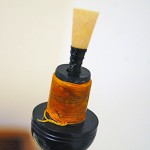Chanter Reed Selection—The Physical Exam
 The ideal bagpipe sound starts with selecting the ideal chanter reed. Obvious? It is not always as easy as it seems. Personal preferences and taste coupled with what amounts to unlimited choice in makers and quality of chanter reed makes that initial task of selecting your ideal reed a bit more daunting. But unlimited choice or no, just pulling a reed from a batch or batches at random will never give you the sound you need. The characteristics of your chanter reed should be suited to you and your needs just as the length of your kilt is suited to your height. Several factors come into play (individual makes notwithstanding) when taking the first step and selecting a chanter reed and all must be weighed accordingly if you are to play the best reed for you.
The ideal bagpipe sound starts with selecting the ideal chanter reed. Obvious? It is not always as easy as it seems. Personal preferences and taste coupled with what amounts to unlimited choice in makers and quality of chanter reed makes that initial task of selecting your ideal reed a bit more daunting. But unlimited choice or no, just pulling a reed from a batch or batches at random will never give you the sound you need. The characteristics of your chanter reed should be suited to you and your needs just as the length of your kilt is suited to your height. Several factors come into play (individual makes notwithstanding) when taking the first step and selecting a chanter reed and all must be weighed accordingly if you are to play the best reed for you.
The Physical Exam
Now, I know that working with natural materials such as arundo donax will make the making of a physically perfect reed an elusive goal for many makers. And the variability of climates, long distance shipping, and overall demand can wreak havoc with the quality of any reed. Yes, “good enough†will always be a suitable goal for some, and physically imperfect reeds have been known to produce an excellent sound for a time. But frankly, it is in the best interests of all bagpipers to demand only the best workmanship and quality out of the reeds being produced these days. The only way to do that is to give the chanter reeds you buy a thorough physical exam before you even put them in your chanter.
All potentially good reeds will show that potential in their physical characteristics before they are even blown. Perform a careful visual inspection on your reeds of choice and work down a checklist of physical points, just like your doctor would when you arrive for your annual physical. It may seem like a lot to consider, but any reed maker worth their salt will be striving for all of these in every reed they produce. Select only the chanter reeds that meet all of the physical characteristics in the checklist below. You can also download the checklist here and keep it handy in your pipe box.
Checklist—Your new chanter reed should be (have):
- Clean and free of dirt.
- No damage, splits, warps, or chipped corners
- Sharp and pointed, not rounded, blade corners.
- Symmetrical overall shape with straight edges and profile.
- Smooth surfaces with no dings or chips.
- Closed/sealed side edges with no sign of space between blades.
- Solid construction with tight wrapping on the staple.
- Good symmetrical curvature on the aperture or opening of the blades.
- Equal thickness at the top of each blade.
- Good alignment of blades at the top and side edges where the blades meet, with no overhang or unevenness.
Whether or not you decide to play a reed that meets some, but not all, of the criteria in the checklist will depend on what kind of use and sound that you require. Some reeds may meet all but one or two of the items on the checklist. You must balance the ultimate effect of the physical defect with how it needs to serve. That is a topic for the next post, “The Match.â€
-
Shawn Husk
 Pipehacker
Pipehacker







